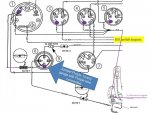TBarCYa
Senior Chief Petty Officer
- Joined
- Apr 13, 2005
- Messages
- 781
I'm rewiring my helm and think I've figured out the killswitch but before I actually do it, I was hoping to find a wiring diagram but haven't had any luck so I'm hoping someone here can let me know if I'm on the right path.
What I have is the key switch that has 3 wires, power, ignition and start. The killswitch also has 3 wires, purple (ignition), black/white and black. When the switch is ON it connects purple to blk/wht. When the switch is OFF it connects blk/wht to blk.
My thinking is that the ignition wire from the key goes to the normal ignition circuits to power the dash and the purple on the killswitch is connected to the same ignition from the key. Black on the killswitch goes to ground and the blk/wht goes to the ignition wire feeding the engine. This way, the dash is always on regardless of the killswitch and the ignition wire at the engine goes to ground to kill the engine when the lanyard is removed.
Does this sound right? I know just disconnecting the ignition wire going to the engine should kill the engine but grounding the ignition wire is also an acceptable method, but why doesn't the key ground the ignition wire?
What I have is the key switch that has 3 wires, power, ignition and start. The killswitch also has 3 wires, purple (ignition), black/white and black. When the switch is ON it connects purple to blk/wht. When the switch is OFF it connects blk/wht to blk.
My thinking is that the ignition wire from the key goes to the normal ignition circuits to power the dash and the purple on the killswitch is connected to the same ignition from the key. Black on the killswitch goes to ground and the blk/wht goes to the ignition wire feeding the engine. This way, the dash is always on regardless of the killswitch and the ignition wire at the engine goes to ground to kill the engine when the lanyard is removed.
Does this sound right? I know just disconnecting the ignition wire going to the engine should kill the engine but grounding the ignition wire is also an acceptable method, but why doesn't the key ground the ignition wire?






















